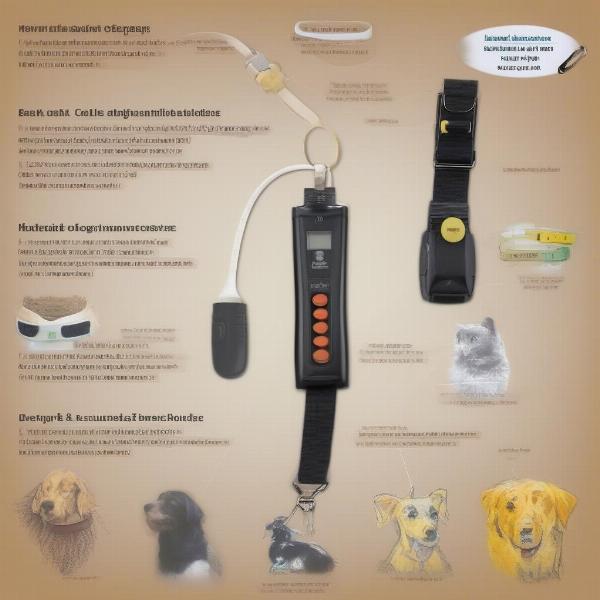Shock collars for dogs that bark, also known as bark collars, are devices designed to curb excessive barking. They work by delivering a mild electric static correction when a dog barks, interrupting the behavior. While they can be effective, their use is controversial and requires careful consideration. Understanding how these collars work, their potential risks and benefits, and the ethical considerations involved is crucial for any dog owner considering this training tool.
Understanding Bark Collars: How They Work and Different Types
Bark collars detect barking through vibrations in the dog’s throat or through sound sensors. When a bark is detected, the collar delivers a stimulus. There are several types of bark collars:
- Static Shock Collars: These collars deliver a brief, mild electric shock. The intensity can usually be adjusted.
- Vibration Collars: These collars vibrate when the dog barks, providing a non-painful but startling sensation.
- Citronella Spray Collars: These collars release a burst of citronella spray near the dog’s nose when they bark. Many dogs find the scent unpleasant.
- Ultrasonic Collars: These collars emit a high-pitched sound that only dogs can hear, designed to deter barking.
 Different Types of Shock Collars for Barking Dogs
Different Types of Shock Collars for Barking Dogs
Are Shock Collars Cruel? Ethical Considerations and Potential Risks
The use of shock collars is a hotly debated topic. Animal welfare organizations and many veterinarians express concerns about the potential for physical and psychological harm. The aversive nature of the shock can cause stress, anxiety, and even aggression in some dogs.
It’s important to consider:
- Misidentification of the Barking Trigger: The collar may activate if another dog barks, unfairly punishing your dog.
- Increased Anxiety: The shock can worsen underlying anxiety issues that may be causing the barking in the first place.
- Physical Harm: Improper use or malfunction can lead to burns or other injuries.
When to Consider a Bark Collar and How to Choose the Right One
A bark collar should only be considered as a last resort after trying positive reinforcement training methods, addressing underlying anxiety, and ruling out medical causes for the barking. If you do decide to use a bark collar:
- Consult with a veterinarian or certified professional dog trainer: They can help determine if a bark collar is appropriate for your dog and recommend the right type and settings.
- Start with the least aversive option: Try a vibration or citronella collar before resorting to a static shock collar.
- Never leave the collar on for extended periods: Only use it during specific times when barking is problematic.
- Monitor your dog closely: Observe for any signs of stress or discomfort.
Training with a Bark Collar: A Step-by-Step Guide
If you are using a bark collar, follow these steps:
- Fit the collar properly: Make sure it’s snug but not too tight.
- Start with the lowest setting: Gradually increase the intensity only if necessary.
- Pair the collar with positive reinforcement: Reward your dog for quiet behavior.
- Be consistent: Use the collar consistently to reinforce the connection between barking and the correction.
- Never use the collar as punishment: It should only be used to interrupt the barking behavior.
Alternatives to Bark Collars: Positive Reinforcement and Addressing the Root Cause
Positive reinforcement methods are often more effective and humane than bark collars. Focus on rewarding desired behaviors, like staying quiet, and addressing the underlying reasons for the barking:
- Boredom: Provide plenty of mental and physical stimulation.
- Territorial barking: Limit your dog’s view of triggers.
- Anxiety: Create a safe and secure environment for your dog.
- Attention-seeking barking: Ignore the barking and reward quiet behavior.
Conclusion: Choosing the Best Approach for Your Barking Dog
Shock collars for dogs that bark can be effective, but they should be used with caution and only as a last resort. Prioritize positive reinforcement training, address the root cause of the barking, and consult with a professional before considering a bark collar. Choosing the right approach can ensure your dog’s well-being while effectively managing unwanted barking.
FAQ
- Are shock collars safe for small dogs? While there are shock collars designed for small dogs, extra caution is needed. Consult with a veterinarian before using one.
- Can a shock collar cause permanent damage? Improper use or malfunction can lead to injuries. Always follow the manufacturer’s instructions.
- What are some alternatives to shock collars? Positive reinforcement training, behavior modification, and addressing the underlying cause of barking are preferred methods.
- How long does it take for a shock collar to work? Results vary depending on the dog and the consistency of training.
- Is it legal to use a shock collar? Regulations vary depending on location. Check your local laws.
- Can a shock collar make my dog aggressive? In some cases, the aversive nature of the shock can worsen aggression.
- How do I choose the right shock collar for my dog? Consult with a veterinarian or certified professional dog trainer.
shock collar for dogs for barking
bark shock collar for small dogs
shock barking collars for dogs
bark shock collars for large dogs
ILM Dog is a leading international online resource for dog owners, providing expert advice on all aspects of dog care, from breed selection and puppy care to senior dog care, training, nutrition, health, grooming, and travel tips. We are committed to providing practical, trustworthy information that empowers dog owners to make informed decisions about their furry friends. For expert guidance tailored to your individual dog’s needs, contact our team at [email protected] or +44 20-3965-8624. ILM Dog is your one-stop shop for all things dog-related.